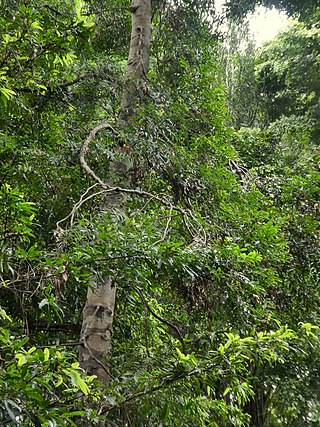
Agathis atropurpurea, commonly known as the blue kauri, and occasionally as the black kauri or purple kauri, is a species of conifer in the very ancient plant family Araucariaceae. The family was distributed almost worldwide during the Jurassic and Cretaceous periods, but is now mostly confined to the Southern Hemisphere. This species is endemic to a small part of northeastern Queensland, Australia.

Calamus australis, commonly known as wait-a-while, hairy mary or lawyer cane, is a plant in the palm family Arecaceae which is endemic to the rainforests of north east Queensland, Australia. Like other species in the genus Calamus, this is a climbing plant with a very long and flexible stem. It uses sharp strong hooks on the fronds and tendrils to attach itself to other vegetation, such as taller established trees, thus gaining support that enables it to grow higher towards the canopy. This species is very similar to C. radicalis, with which it coexists, but is smaller in almost all respects.

Pseuderanthemum variabile, commonly known as pastel flower or love flower in its native range, or night and afternoon in the USA, is a small perennial herb in the family Acanthaceae which is native to Australia, Papua New Guinea and New Caledonia. It can be an unwelcome nuisance in orchid nurseries in Australia.

Alchornea ilicifolia, commonly known as the native holly, is a bush of eastern Australia. It grows in or on the edges of the drier rainforests in coastal parts of New South Wales and Queensland.

Calamus muelleri, commonly known as southern lawyer cane or wait-a-while, is a climbing palm with a vine-like habit, endemic to the subtropical coastal rainforests of northern New South Wales and southern Queensland. Sharp hooks on the plant can snag the clothing of walkers in these forests, giving rise to the name "wait-a-while".

Carnarvonia araliifolia, commonly known as the red oak, red silky oak, Caledonian oak or elephant's foot, is the sole species in the monotypic genus Carnarvonia, a member of the Proteaceae plant family. It is endemic to the rainforests of northeastern Queensland.

Dysoxylum arborescens, commonly known in Australia as Mossman mahogany, is a small tree in the mahogany family Meliaceae. It is native to rainforests of Malesia, Papuasia, Queensland and nearby islands.

Gardenia ovularis is a small tree in the family Rubiaceae. It is endemic to a very restricted part of north east Queensland, namely the coastal rainforests from the Bloomfield River southwards to Etty Bay, and with a further isolated occurrence at Mount Elliot, south of Townsville It was first described by Frederick Manson Bailey in 1893.
Stephania tuberosa is a plant in the family Menispermaceae which is endemic to Queensland. It grows as a vine with a stem diameter of up to 5 cm (2.0 in) and produces a distinctive large tuber on the ground which can be up to 50 cm (20 in) diameter.

Calamus moti is a climbing rainforest plant in the palm family Arecaceae, which is endemic to Queensland. It has a slim flexible stem which does not support the plant, instead it climbs to the forest canopy with the assistance of long tendrils armed with stout recurved hooks.

Calamus radicalis, commonly known as vicious hairy mary, is a plant in the palm family Arecaceae endemic to the rainforests of north east Queensland, Australia. Like other species in the genus Calamus, this is a climbing plant with a very long and flexible stem. It uses sharp strong hooks on the fronds and tendrils to attach itself to other vegetation, such as taller established trees, thus gaining support that enables it to grow higher towards the canopy. This species is very similar to C. australis, with which it coexists, but is larger in almost all respects.
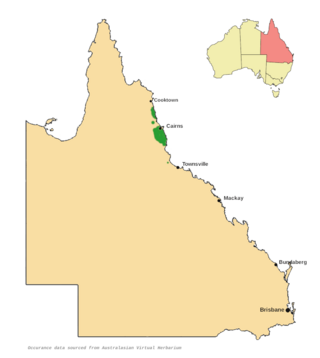
Endiandra sankeyana, commonly known as Sankey's walnut, is a plant in the family Lauraceae endemic to the Wet Tropics of Queensland.

Syzygium tierneyanum, commonly known as river cherry, water cherry, or Bamaga satinash, is a tree in the family Myrtaceae which is native to New Guinea, the Solomon Islands, Vanuatu and north east Queensland. It often grows along watercourses where it is a facultative rheophyte.
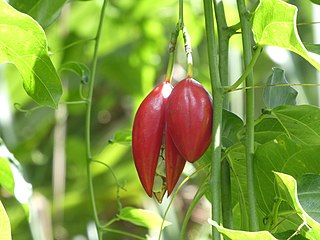
Adenia heterophylla, commonly known in Australia as the lacewing vine, is a climbing plant in the family Passifloraceae. It has a broad distribution spanning the equator, from the south eastern corner of China, through Indochina and Malesia, to northern Australia. In Australia it serves as a food plant for larvae of the glasswing, red lacewing and cruiser butterflies.

Hypserpa laurina is a slender twining climber in the plant family Menispermaceae. It is native to New Guinea and north eastern Queensland in Australia.
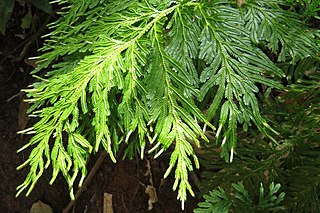
Selaginella longipinna, commonly known as the electric fern, is a plant in the spike moss family Selaginellaceae. It is endemic to northeastern Queensland, growing in rainforest and closed forest from Cooktown to near Mission Beach, including the Atherton Tablelands. It is a terrestrial plant forming a dense cover to 40 cm (16 in) high, often near streams.

Selaginella australiensis is a plant in the spikemoss family Selaginellaceae endemic to northeastern Queensland. It grows in rainforest and closed forest from Cooktown to near Mission Beach, including the Atherton Tablelands. It is a low growing and much branched terrestrial plant inhabiting damp shady locations, typically along stream banks.
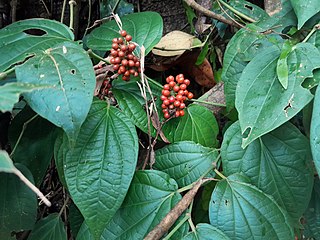
Piper hederaceum, also known as the giant pepper vine, is a vine in the pepper family Piperaceae. It is endemic to eastern Australia, growing in rainforests from Lockhart River, Queensland to Bermagui, New South Wales.
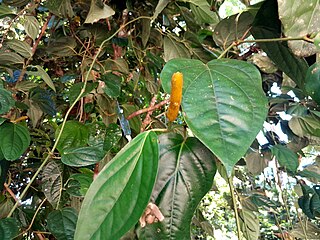
Piper mestonii, commonly known as Queensland long pepper or simply long pepper, is an evergreen vine in the pepper family Piperaceae native to rainforests of New Guinea and Queensland, Australia.

Piper interruptum is a vine in the pepper family Piperaceae, native to the eastern parts of Southeast Asia and to Melanesia and Queensland.























